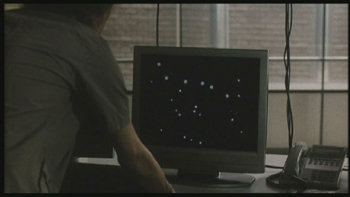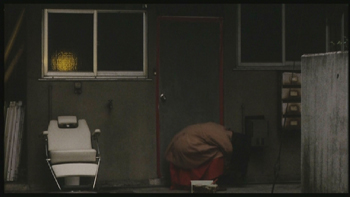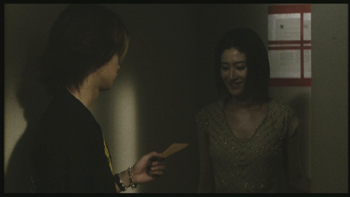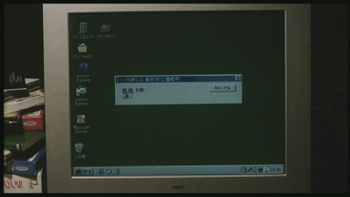 BUY IT AT AMAZON: CLICK HERE!
BUY IT AT AMAZON: CLICK HERE!
STUDIO: Magnolia Home Entertainment
MSRP: $26.98
RATED: R
RUNNING TIME: 119 Minutes
SPECIAL FEATURES:
• "Making-of" featurette
• Theatrical trailer
Horror tends to follow technology. Any new
frontier of human capability is filled with equal measures of hope and fear.
While the scientists and researches concentrate on the hope, it seems much more
practical for storytellers to focus on the fear. When space travel became more
than a dream, popular entertainment began imagining what horrors we might
encounter in the stars, and what they would say about us. With the advent of
nuclear weaponry, books and films began to consider unimaginable devastation
and its effects on humanity.
Our most recent popular technology is the Internet.
Not a small number of entertainment media have exploited worldwide,
instantaneous communication for their scary stories. There have been thrillers
in which the Internet is a medium for connecting hunters and victims; there
have been supernatural fantasies that invest a malevolent personality in the
wires. Most of these fall short of being truly frightening because they treat
the technology as a catalyst to action, a thing of itself and devoid of
meaning.
Not so with Pulse. Director Kiyoshi
Kurosawa has tightly woven the concepts of Internet technology into a deeply
unsettling film, capitalizing on the paradoxical isolation that results from
such a capacity for communication, and digging at the common human fear of loneliness
with the finesse of poking a needle at a splinter you can’t quite reach.

Amidst rampant looting and liberating, the Coke stood alone.
The Flick
It’s nothing new for the marketing of a film to
get the essence of that film totally wrong, but I really have to address this
issue with Pulse. The tagline you’ll read on various materials
is, in its entirety: "Japanese teens investigate a series of suicides
linked to an internet webcam that promises visitors the chance to interact with
the dead." This sets you up for a film with a misplaced youthful energy,
the sort of movie that might get tagged with a PG-13 rating. It puts you in
mind of Fear Dot Com. It really shouldn’t.
Instead, you should be thinking of Serial
Experiments Lain, an anime series by Yoshitoshi ABe, known for its long
stretches of silence and storytelling restraint. The characters in Pulse
are confronted with mysteries that terrify rather than intrigue. Men and women
all over Tokyo have strange interactions with what we assume are ghosts, and
then they disappear, sometimes right in front of an observer. Pulse
does not focus on a haunted webcam; it is not a story of people coming together
to defeat a ghost; it does not feature a plucky team of misfits exploring the
spirits of Tokyo.
This is because all the primary characters of Pulse
operate in isolation. Because of their jobs, their histories, and their
natures, they exist without a meaningful connection to another single human
being. Their small attempts to create an artificial closeness are destroyed,
sometimes in self-destruction, sometimes by the efforts of the other party. The
land that Kurosawa creates is a land of loneliness.

Born in humble monochrome, Geometry Wars soon
blossomed into a beautiful young woman.
The lynch-pin symbol for the film isn’t the
Internet, exactly, but a simulation program written by a grad student at a
Tokyo university. The program is similar to Conway’s Game of Life, in that it’s
populated by a number of artificial life forms governed by a simple algorithm
that yields complex results. The algorithm for Pulse‘s game of
life is: 1) Life forms that are distant will be drawn together, and 2) Life
forms that occupy the same space both will die. Essentially, its a map of the
tension of human interaction, showing that no one can live alone, but at the
same time no one can truly be close to another person.
With this set of rules guiding the characters and
their interactions with ghosts, the Internet becomes less of a cause of horror,
and more a symptom of the human tendency toward isolation. We struggle to be
integrated, to fight our way into whatever social circle attracts us, but, at
least by one defeatist philosophy, we cannot exist there without disrupting the
state of the people around us. According to Pulse, the
technologies of communication in out new century are providing us with another
means to impress ourselves upon other people, while remaining wholly separate.
I’m not sure if this fear of isolation is local
to Japan, or if it bleeds over into mainstream America as well. I know that I’m
respectful of the power the Internet has to compartmentalize human
interactions. Beyond the Internet, though, we tend to have a society that is
de-emphasizing face-to-face interaction. From what I have read, that sort of
societal change is far more advanced in Japan, which helps to explain some of Pulse‘s
context.
The cultural context isn’t the only thing that
may appear alien to a Region 1 audience. In order to foster a sense of unease,
Kurosawa goes to great lengths to "strange the familiar," lacing
common situations with dread in the same way a nightmare subverts dull
experience. One of the methods he employs is fairly common in Japanese
entertainment, that of bombarding the audience with concepts and rules for the
world of the film.
It doesn’t ever feel as self-important as the
pontificating of The Matrix trilogy; instead, the audience gets
the impression that they have been thrust into a new world, one that does not
begin with a tutorial level of any sort. It’s a simultaneous encouragement to
the viewer to submerge into the story and reward for doing so.

Annabell Lee, certain that Tokyo would soon be submerged,
set about making her house watertight.
Another method Kurosawa uses is the slight
alteration of tradition ghost story tropes. For example, the ghosts in Pulse
do not attack the human characters. They do not crawl out of television sets to
murder those unfortunate enough to like art films. They merely exist and that
is enough to ruin the minds of those they encounter. It’s almost Lovecraftian
the way that encountering a ghost in Pulse causes the brain to
shrivel, and to realize its total insignificance. But the worst part about the
ghosts is the message they bring to the protagonists: In life, you are alone by
your choice; in death, you are alone forever. The rules of the afterlife have
been stranged, and there is no more room for hope.
As you might expect from my rambling, the horror
in Pulse is far more cerebral than visceral. In a way, it’s
almost closer to Gattaca than to its J-horror brethren. The
horrors faced aren’t the stuff of fantasy, but the stuff of life exaggerated. That’s
not to say the film lacks scares — the sound design is brilliant at
emphasizing the crushing fear of a human’s encounter with a spirit, and the
cinematography for these sequences is dark and moody.
The ghosts don’t jump out at the audience; they
appear in the distance of focus and slowly integrate themselves into the scene.
Kurosawa focuses on creating the feeling of the slow onset of fear, rather than
its cousin the cold, sudden sweat. There are several key horror sequences that
are paced and shot beautifully, most compelling of which is a clever twist on
the old story of the woman who put together a puzzle that showed her sitting at
her table, putting together a puzzle.
I do have a few nitpicks of varying importance
with the film’s construction. The only significant one is that the acting of
the leads is occasionally stilted. In key emotional scenes throughout the first
half, you can almost hear Kurosawa instructing the actors to change their
emotions. The kids that play the protagonists aren’t quite seasoned enough to
pull off the see-saw mental states they go through, though things smooth out
considerably in the second half.
I praised Kurosawa for deliberately occluding the
rules of the Pulse world, but I do want to recognize that this
kind of restraint has the unfortunate side effect of distancing a certain
audience. It’s a limiting factor to the film’s appeal, which further serves to
whisk it off into some dark corner of subgenre classification. Also, for a film
about computers, there are some notable groaners in the tech dialogue that will
jump out to the computer literate among us. It’s not because the film was made
five years ago and the tech is outdated, it’s just that computer exposition
needed to be simplified so as not to distract from the story. Still, it’s a
movie that uses technology as a central metaphor, so the mistakes are evident.

"That’s not a fifty. That’s not even real money.
Oh, what the heck. Off with your pants."
The resolution of Pulse comes with
a dose regretful cynicism, as horror should be. The best horror displays our
human failings and exaggerates what will happen if we don’t control them. "Man’s
inhumanity to man" is a common enough phrase regarding war and violence,
but Kurosawa does a fine job applying it to something so mundane and universal
as having a friend.
There is a remake of Pulse coming
soon from Hollywood. I haven’t seen anything relating to it, so I can’t vouch
for its quality. One thing I hope they will retain is the thoughtful, half-realized
moral of the story. This is horror that means something; it’s rare to encounter
a cautionary tale so steadfast in its conviction, and so perfectly defeatist in
its attitude.
You’ll hear this phrase a thousand times in your
life: "Technology is driving us apart." You’ll hear it from futurists
and grandmothers, from luddites and politicians. It’s a valuable thing to hear
it from a storyteller as gifted as Kiyoshi Kurosawa.
9 out of 10
The Look
1.78:1 widescreen. Heavy blacks are a bit of a
problem in the transfer, with noticeable artifacting. This is extremely
disruptive with a film that places many of its signature scenes in dark rooms.
As far as the cinematography goes, Kurosawa goes
for the deep focus. His sets are filled with detail. Often, actions (scary and
otherwise) occur behind whatever speaking character is on screen. This goes a
long way to cementing the world as a real place, rather than a limited set in
which your eye is forced along a deliberate path.
8 out of 10

In this world, the DVD Rack Babe takes five minutes to download.
Five glorious minutes.
The Noise
You get one Japanese-language audio track in a
simple 2.0 stereo. There is no English dub. If you poke around the dark corners
of the Internet, you may see people complaining about synchronization issues
between the subtitles and the dialogue, but I encountered no such problems.
The sound design of Pulse is an
integral part of its success. Effects are heightened and exaggerated, so that
everything comes through with almost painful clarity, like when you’re hung
over. It’s a decision that serves to convince the viewer to suspend his
disbelief, because the overall effect is reminiscent of home movie sound
recording, where certain things come through physical transmission at an
unexpected volume.
It does lack a higher quality audio track. This
is a film that would really have benefited from a DTS or high-end Dolby
surround mix. Still, I have a lot of admiration for what Kurosawa pulled off
despite technical limitations.
8.6 out of 10

The nearsighted have significantly more problems during hauntings.
The Goodies
There are very few bonuses here. You get one short "making-of" documentary, which is interesting if for no other reason than to see the contrast between how Japanese filmmakers approach their work and how Americans do.
You also get a theatrical trailer.
3.5 out of 10
The Artwork
It’s a striking cover, a collage of disparate
elements. I like the jagged red border, reminiscent of the recurring image of
red tape (a sort of Biblical metaphor) in the film. It’s the sort of cover art
that warns a potential viewer away, which, like "No Trespassing"
signs, just pulls you right in.
8 out of 10
Overall: 8.8 out of 10